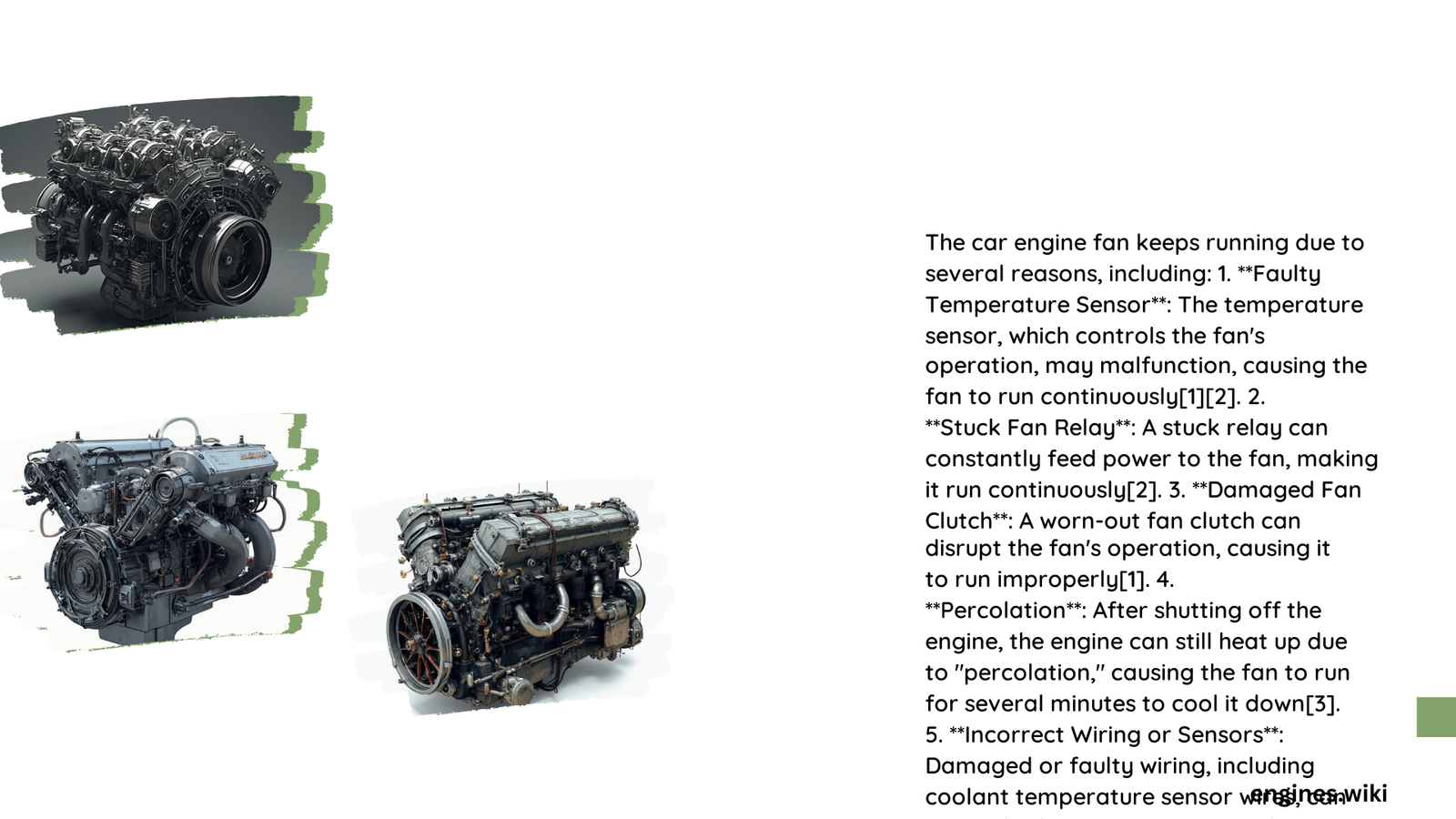Modern vehicles rely on complex cooling systems where radiator fans play a crucial role in temperature regulation. When a car’s engine fan continues running unexpectedly, it signals potential underlying mechanical or electrical issues that demand immediate attention. Understanding these mechanisms can help vehicle owners diagnose and resolve persistent fan operation efficiently, preventing potential engine damage and unnecessary electrical drain.\n\n## What Causes Continuous Radiator Fan Operation?\n\n### Are Temperature Sensors Malfunctioning?\n\nTemperature sensors are primary culprits in continuous fan operation. These critical components monitor coolant temperature and communicate with the Engine Control Unit (ECU). When malfunctioning, they can send incorrect signals, triggering persistent fan activation.\n\n#### Key Diagnostic Indicators\n- Unexpected fan running when engine is cold\n- Inconsistent temperature readings\n- Electrical system irregularities\n\n### Can Electrical Components Be Problematic?\n\nElectrical system failures frequently contribute to continuous fan operation. Specific components like fan relays and wiring connections can develop faults that prevent normal fan cycling.\n\n| Component | Potential Issue | Diagnostic Method |\n|———–|—————-|——————-|\n| Fan Relay | Stuck Contact | Voltage Test |\n| Wiring Harness | Short Circuit | Continuity Check |\n| ECU | Signal Malfunction | Computer Diagnostic Scan |\n\n### How Do Cooling System Conditions Impact Fan Operation?\n\nCoolant levels, quality, and system pressure significantly influence radiator fan behavior. Low coolant or degraded fluid can trigger continuous fan operation as a protective mechanism.\n\n#### Critical Coolant Considerations\n1. Maintain recommended fluid levels\n2. Check coolant concentration regularly\n3. Inspect for potential leaks\n4. Monitor system pressure\n\n### What Are Potential Mechanical Failures?\n\nMechanical issues like damaged fan clutches or worn bearings can cause persistent fan running. These problems often require professional mechanical assessment and potential component replacement.\n\n#### Symptoms of Mechanical Fan Issues\n- Unusual noise during fan operation\n- Inconsistent fan speed\n- Physical damage to fan blades\n- Excessive vibration\n\n### How to Diagnose and Resolve Continuous Fan Operation?\n\n#### Professional Diagnostic Steps\n1. Connect diagnostic scanner\n2. Check temperature sensor resistance\n3. Test fan relay functionality\n4. Inspect wiring connections\n5. Evaluate coolant system integrity\n\n### Cost and Time Implications\n\n| Repair Type | Estimated Cost | Time Required |\n|————-|—————-|—————|\n| Sensor Replacement | $50 – $200 | 1-2 Hours |\n| Relay Repair | $30 – $150 | 30-60 Minutes |\n| Complete Cooling System Diagnosis | $100 – $300 | 2-4 Hours |\n\n## Preventive Maintenance Recommendations\n\n- Schedule regular cooling system inspections\n- Replace coolant according to manufacturer recommendations\n- Address warning signs promptly\n- Use high-quality replacement parts\n\n### Final Technical Insights\n\nContinuous radiator fan operation represents a complex interaction between electrical, mechanical, and thermal systems. Systematic diagnosis and timely intervention can prevent extensive engine damage and costly repairs.\n\n### Reference:\n- SAE International Cooling System Research\n- Automotive Maintenance Technical Guidelines\n- Professional Mechanic’s Diagnostic Manual

